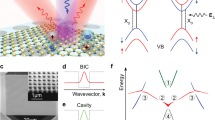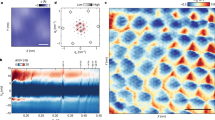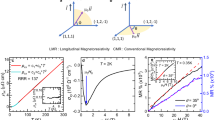Abstract
WE here report a linear dichroism (LD) exhibited by isotropic chromophores in a condensed anisotropic medium and caused by anisotropic effective local fields. We shall call the effect Wiener dichroism (WLD) when the anisotropic reaction field arises from the presence of two (or more) different dielectric domains (phases in our notation) which are internally isotropic but which are separated by surfaces with non-spherical geometry. With a coloured cubic anion, like Co(NO2)3−6, in the aqueous phase of a 20% solution of cetyltrimethylammoniumbromide (CTAB), known to contain rod-shaped micelles, a positive WLD is observed, while a cation, like Co(NH3)3+6 yields negative WLD, when the micelles are oriented. This difference between cations and anions arises from the different average locations of the ions with respect to the cylindrical counter-ion layer surrounding the micelle. This is the first time a dichroism has been observed caused exclusively by local fields.
This is a preview of subscription content, access via your institution
Access options
Subscribe to this journal
Receive 51 print issues and online access
$199.00 per year
only $3.90 per issue
Buy this article
- Purchase on SpringerLink
- Instant access to full article PDF
Prices may be subject to local taxes which are calculated during checkout
Similar content being viewed by others
References
Fraser, R. D. B., J. chem. Phys., 21, 1511–1515 (1953).
Sackman, E., and Möhwald, H., J. chem. Phys., 58, 5407–5416 (1973).
Davidsson, Å., and Nordén, B., Chem. Scr., 9, 49–53 (1976).
Flory, P. J., and Abe, Y., Macromolecules, 2, 335–342 (1969).
Noda, I., and Hearst, J. E., J. chem. Phys., 54, 2342–2354 (1971).
Michl, J., Thulstrup, E. W., and Eggers, J. H., J. phys. Chem., 74, 3868–3878 (1970).
Gō, N., J. phys. Soc. Japan, 23, 88 (1967).
Wiener, O., Abh. sacks. Akad. Wiss., 32, 509–604 (1912).
Bragg, W. L., and Pippard, A. B., Acta Crystallogr., 6, 865–867 (1953).
Mayfield, J. E., and Bendel, I. J., Biopolymers, 9, 655–675 (1970).
Copic, M., J. chem. Phys., 26, 1382–1390 (1957).
Perutz, M. F., Acta Crystallogr., 6, 859–865 (1953).
Johansson, B. Å., Lindblom, G., and Nordén, B., Chem. Phys. Lett., 39, 128–133 (1976).
Liptay, W., Weisenberger, H., Tiemann, F., Eberlin, W., and Konopka, G., Z. Naturf., 23, 377–393 (1968).
Neugebauer, H. E., Can. J. Phys., 32, 1–8 (1954).
Vuks, M. F., Optics Spectrosc., 20, 361–364 (1966).
Rohleder, J. W., and Luty, T., Molec. Crystallogr., 5, 145–163 (1968).
Bakhshiev, N. G., Girin, O. P., and Libov, V. S., Optics Spectrosc., 14, 395–397 (1963).
Author information
Authors and Affiliations
Rights and permissions
About this article
Cite this article
NORDÉN, B., DAVIDSSON, Å. & JOHANSSON, L. Linear dichroism of cations and anions in micellar solutions. Nature 261, 400–402 (1976). https://doi.org/10.1038/261400a0
Received:
Accepted:
Issue date:
DOI: https://doi.org/10.1038/261400a0



